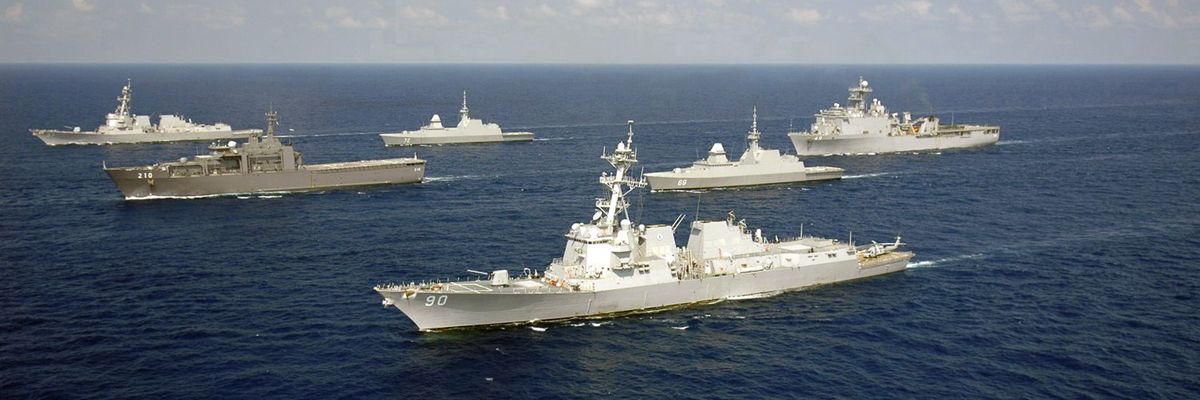United States Secretary of State Mike Pompeo’s statement last week rejecting most of China’s claims in the South China Sea made explicit the longstanding implicit U.S. position toward China’s ongoing efforts to assert control there. Until now, the U.S. has expressed its objections to this behavior first of all by pointed displays of military might in the area, a tactic it has evidently not abandoned; last Monday’s announcement was followed a day later by a “freedom of navigation operation” in the Sea, the sixth this year.
Meanwhile, the Trump administration continues to insist on including China in trilateral arms control negotiations in lieu of extending New START, despite China’s repeated, explicit refusals to take part unless U.S. and Russian nuclear arsenals are first reduced to similar levels to its own, approximately 300 warheads. This isn’t the first time a fixation on China has stymied reasonable steps toward a better arms-control situation, or, depending on your perspective, been used as an excuse to avoid engaging by an administration that views diplomacy as a sign of weakness. When the U.S. announced its withdrawal from the bilateral Intermediate-Range Forces Treaty with Russia, the fact that most of China’s nuclear weapons would be illegal under that treaty — if China were party to it — was cited as justification for U.S. withdrawal.
How do we square these two approaches to China policy: one that seems to acknowledge, however begrudgingly, the value of diplomatic engagement, one committed to “strategic competition” — or outright aggression? It’s not an unfamiliar pattern to anyone who has followed the recent history of American diplomacy, where diplomatic overtures are quickly and unpredictably abandoned in favor of threats of dire consequences in the event of non-compliance. But the stakes are high, as they always are when nuclear-weapons countries are involved. Whether or not these two approaches currently draw from a well thought-out strategy, the outcomes are closely related, and they will have a profound effect on a range of other issues that fall within the scope of the U.S.–China relationship. A unified approach to China policy from the United States is essential, one that acknowledges the difficulty and the necessity of conducting substantive negotiations to reduce the risk of nuclear conflict and make real progress toward disarmament.
Those looking for a starting point for a promising long-term strategy for nuclear negotiations between the U.S. and China could do much worse than the South China Sea. It’s perhaps unique as a place where U.S. and Chinese forces regularly come into close contact, and it’s a focal point of Chinese conventional and nuclear military buildup. As China builds up land, air and sea-based capabilities, and the US conducts freedom of navigation operations, overflights, and sends an aircraft carrier into the area for the first time in over five years, the possibility of an incident escalating into a conflict cannot be discounted.
What is to be done? An initial step would be for the U.S. to ratify the U.N. Convention on the Law of the Sea. This most recent change in U.S. policy cites a ruling by the Permanent Court of Arbitration which upheld the Philippines’ claims in the Sea over China’s. Though rejections of the possibility of U.S. ratification have been based on the notion that the U.S. has nothing to gain from doing so, it’s clear that today the U.S. believes it stands to gain from a strengthened role for international law in governing use of the Sea. More importantly, it’s a way to set the tone for a future relationship with China guided by mutual adherence to multilateral treaties.
U.S. policy can further this approach by working to implement existing agreements that have sought to establish “rules of the road” for use of the area. It can simultaneously take a real first step toward substantive nuclear weapons negotiations with China by pursuing a bilateral No-First-Use declaration as the foundation of this effort. China already maintains a unilateral No-First-Use policy, and an approach to U.S.–China relations guided by suspicion and quick recourse to aggression would discount such a move as a bad deal. But formally establishing such a policy as the basis of the relationship would take seriously the very real possibility that one of the semi-regular “near misses” between U.S. and Chinese military ships and aircraft could lead to uncontrolled escalation, with potential global consequences.
New START was only the last chapter in a decades-long commitment to arms-control negotiations that brought the number of nuclear warheads worldwide down from nearly 70,000 in the mid-1980s to about 15,000 in 2018. That’s over 30 years of work spanning six U.S. presidencies. There’s no reason that ambitious diplomacy with China isn’t possible, but it will likely require a similar commitment of time and effort. Rather than starting by asking for everything and offering nothing, U.S. policymakers should start with the situation at hand by affirming ground rules for use of the South China Sea that take into account the real risks inherent to conflict between two nuclear-armed countries.
















